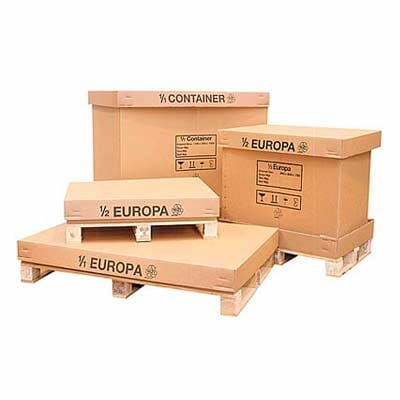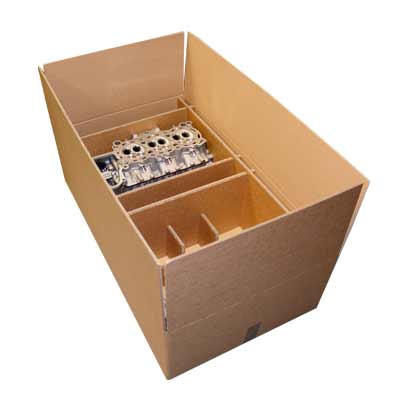If your business ships specialist products, parts or equipment, composite packaging provides the highest levels of protection in transit.
Composite packaging is that which combines various materials. Industrial composite packs are typically manufactured from a combination of corrugated cardboard, timber, and low-density foams (including Plastazote, Stratocell and Ethafoam). Composite packaging provides precise levels of protection for heavy, bulky, delicate or expensive items during transit. Read more
£POA





- No obligation and no pressure quotes for any packaging.
- Free and impartial advice from UK based packaging experts.
- Competitive pricing and full customisation options.

Size-optimised

Reusable

UK made

About composite packaging
Typically created from a range of materials, including cardboard, plywood, plastics, barrier bags and foams, composite packaging is arguably most successful when using a combination of durable corrugated cardboard, timber and engineered foam inserts.
GWP can provide your business with custom-sized, fully tailored composite packs using these materials – as well as Correx® plastic instead of traditional corrugated cardboard outers – that provide the optimum level of protection for your specific parts or products.
Using composite packaging to prevent damage not only reduces your business’ ongoing costs but also has a range of other benefits.
It reduces the need for sending costly replacements and the burden of processing customer returns. It also leads to improved customer satisfaction – through reliable supply – and aids the potential for repeat business.
It also minimises the cost of damaged or written-off stock to your business.
As a result, composite packaging is hugely successful for safely transporting heavy, bulky, expensive, delicate and specialist products and equipment.
GWP select a suitable form of outer transit packaging and foam material based on complex calculations to ensure that any items you are shipping will have a truly bespoke level of protection.
But there are more options for your composite packs.
Besides the material choices, if you use corrugated packaging for your outer box, it is possible to enhance this further with several coatings. Additional properties this provides include moisture resistance, anti-static, anti-scuff surfaces and even the ability to inhibit corrosion (VCI).
These coatings are in addition to exterior printing for branding, logos, instructions, part numbers, etc.
GWP can also engineer the foam element to improve the efficiency of your packing operation, reducing labour costs into the bargain. You can also add pallets to larger composite packs and unique features such as ramps for unloading heavy items at their destination.
Finally, composite packaging can either be supplied in component form (for erection at your site) or fully assembled to improve your productivity further.
Key benefits of composite packs
The key benefits of composite packaging includes the following:
- Exceptional levels of transit protection.
- Optimised for your specific product/requirements.
- Cost reduction through minimised returns, plus improved customer satisfaction.
- Can also aid packing efficiency.
- Various outer material grades and strengths.
- Can be produced using Correx® plastic material.
- Can include pallets for ease of movement.
- Various printing options.
- Can be supplied fully assembled.

Reusable
The durable nature of composite packaging means it is typically reusable over multiple trips.

Size optimised
Composite packaging is manufactured to custom sizes, minimising transit emissions and CO2.

Recycled content
The corrugated cardboard element of composite packaging contains between 50 to 70% recycled material.

Recyclable packaging
The various elements of composite packaging are generally recyclable (but may require specialist recycling centres).

Water based inks
GWP use water based inks when printing your heavy duty packaging.

UK manufactured
GWP manufacture your composite packaging in the UK, reducing emissions from transport.

Composites
Composite packaging uses a number of different materials in its construction (please ask for specific details)
What is composite packaging?
Composite packaging is effectively a form of packaging that combines different materials. Materials used are typically corrugated cardboard, timber and foams but can also include Correx®, plastics, barrier bags and other commonly used packaging materials. The mix of materials allows composite packaging to achieve much higher levels of transit protection.
Is foam environmentally friendly?
Whilst many foams use recycled and recyclable materials, they are more difficult to process than corrugated cardboard. However, foam packaging can be used over multiple trips, improving sustainability. As they can prevent severe damage to parts or components (which may, as a result, end up in landfill), they can be a sensible choice for many applications.
Do composite packs help prevent damage in transit?
Composite packs can provide specific levels of protection for your products. It is even possible to use specialist software to precisely calculate the amount and type of foam required to protect from particular handling conditions. As such, they can often wholly eradicate any issues you have with product damage during shipping.
Can composite packs be printed?
Using corrugated cardboard (or Correx®) for your outer composite packaging, you can have this printed using several different techniques. Printing allows the addition of simple logos, instructions, and even complex graphics and diagrams to your packaging.
Does composite packaging include pallets?
Larger composite packaging can include timber pallets to allow for easier storage and movement of products. Adding other specialist features, such as ramps to help unload bulky items on castors or wheels at their destination, is possible.
Is composite packaging reusable?
Although composite packaging is generally designed for a single trip, its durable nature means it is not uncommon for businesses to use packs over multiple journeys.
Are composite packs recyclable?
Once separated into their differing components, the vast majority of a composite pack can be recycled. Cardboard elements are collected as part of typical recycling services, whilst wood is also widely recycled. The end user must take elements, including foams and Correx, to specialist recycling centres.
Composite packaging prices
Due to the nature of composite packaging – in that it is created to offer precise protection for a specific product – it is impossible to list prices on this website.
The material mix, sizing, design complexity, total number required, and testing requirements all impact the final price.
Free quotes and advice
However, you can request a free, no-obligation quote on any composite packaging your business requires. A team of expert designers will create a concept based on your specific product and expected handling processes whilst also providing advice on the best options for your application.
Related products
Quotes, Technical Info, Advice...
Get your no obligation, tailored quote (or impartial product advice) now
Here to Help
Contact a member of our sales & support team directly

John Elliott
Product Adviser
packaging@gwp.co.uk
01793 754 444

Bill Chapman
Sales
packaging@gwp.co.uk
01793 754 444

Ian Heskins
New Business Director
ian.heskins@gwp.co.uk
01793 754 444

01793 754 444
Mon – Fri 08.00 – 17.00

packaging@gwp.co.uk
Email a packaging expert




















































